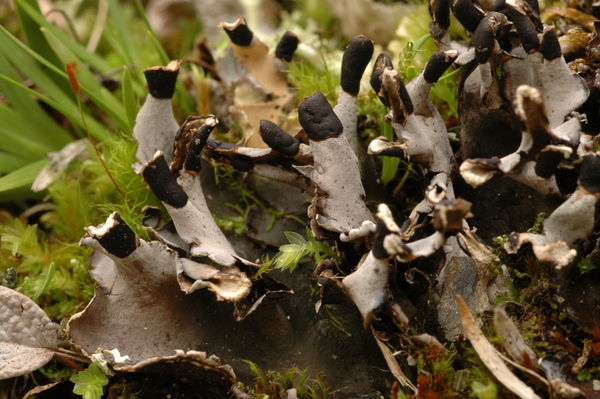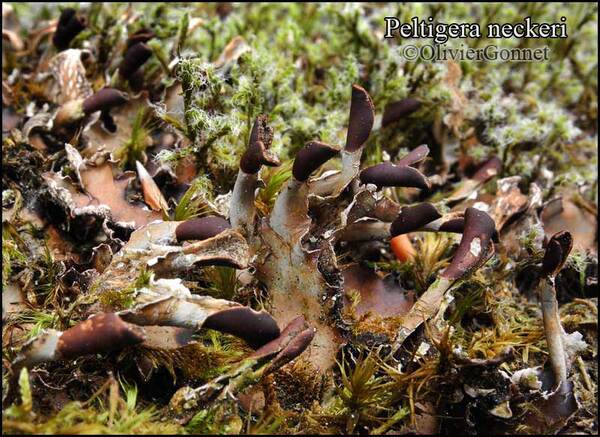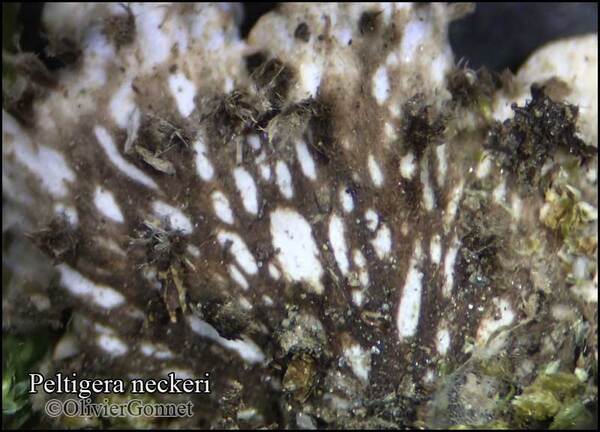Peltigera neckeri Müll. Arg.
Hepp ex Müll. Arg., Mém. Soc. Phys. Hist. Nat. Genève: 16, 2: 370, 1862.
Synonyms: Peltigera horizontalis f. rubescens Trass; Peltigera polydactyloides var. velebitica Gyeln.?; Peltigera polydactylon f. debilis Lettau; Peltigera polydactylon var. nervosa Gyeln.; Peltigera polydactylon var. nigrovenosa Savicz & Rass.
Distribution: N - VG (TSB 2901), Frl (Tretiach & Molaro 2007), Ven (Massalongo Lich. Ital. 260: Vitikainen 1994), TAA (Vitikainen 1994, Nascimbene 2006c), Lomb (Vitikainen 1994, Gheza 2019b, Gheza & al. 2022), Piem (Vitikainen 1994), Emil (Vitikainen 1994, Benesperi 2001, 2009, Fariselli & al. 2020), Lig (Vitikainen 1994, Benesperi & al. 2001, Giordani & al. 2025). C - Tosc (Vitikainen 1994, Benesperi 2001, 2006, Benesperi & Tretiach 2004, Brackel 2015, 2025), Umb (Genovesi & al. 2001, 2002, Ravera & al. 2006), Abr (Recchia & Villa 1996, Brackel 2015, Gheza & al. 2021), Mol (Nimis & Tretiach 1999, Caporale & al. 2008), Sar (Vitikainen 1994, Zedda 2002, Brackel & Berger 2019). S - Pugl (Vitikainen 1994, Nimis & Tretiach 1999), Bas (Potenza 2006, Potenza & Fascetti 2012), Cal (CLU 5479), Si (Vitikainen 1994).
Description: Thallus foliose, broad-lobed, heteromerous and dorsiventral, slate blue to (rarely) brownish grey when dry, blackish grey when wet, loosely attached, forming 10-20 cm wide rosettes. Lobes elongate, flattened, contiguous, with rounded ends and upturned margins, 0.7-1.5 cm broad, 3-4 cm long, often faintly pruinose at margins, the upper surface glabrous, shiny, smooth, sometimes cracked, undulate. Lower surface pale at margin, darker in central parts, with a network of broad to indistinct, reticulated, dark and raised veins, and with diffuse to fasciculate, 3-6 mm long, dark rhizines. Upper cortex pseudoparenchymatous; medulla white; lower cortex absent. Apothecia frequent, saddle-shaped becoming tubular, on short, ascending lobes, the disc dark brown turning black, 3-8 mm long. Paraphyses simple, distinctly thickened in upper part. Asci 8-spored, Peltigera-type, fissitunicate, the thickened apex with a K/I+ blue ring. Ascospores 3-(-5) septate, hyaline to very pale brown at maturity, acicular, thin-walled, (31-)50-70(-80) x (2.5-)3-4(-5.2) µm. Pycnidia rare, dark, immersed. Conidia fusiform. Photobiont cyanobacterial (Nostoc, the cells not in long chains). Spot tests: cortex and medulla K-, C-, KC-, P-, or medulla sometimes faintly and fleeting C+ and KC+ pale pink. Chemistry: tenuiorin, methyl gyrophorate, gyrophoric acid, hopanes, and unidentified terpenoids.Note: on soil and on terricolous, epiphytic and silicicolous mosses, with a wide altitudinal range but most frequent in humid-warm beech forests, from the Alps to the mountains of Southern Italy.
Growth form: Foliose, broad lobed
Substrata: soil, terricolous mosses, and plant debris
Photobiont: cyanobacteria, filamentous (e.g. Nostoc, Scytonema)
Reproductive strategy: mainly sexual
Most common in areas with a humid-warm climate (e.g. most of Tyrrenian Italy)
Commonnes-rarity: (info)
Alpine belt: extremely rare
Subalpine belt: rare
Oromediterranean belt: absent
Montane belt: rather rare
Submediterranean belt: extremely rare
Padanian area: absent
Humid submediterranean belt: very rare
Humid mediterranean belt: extremely rare
Dry mediterranean belt: absent
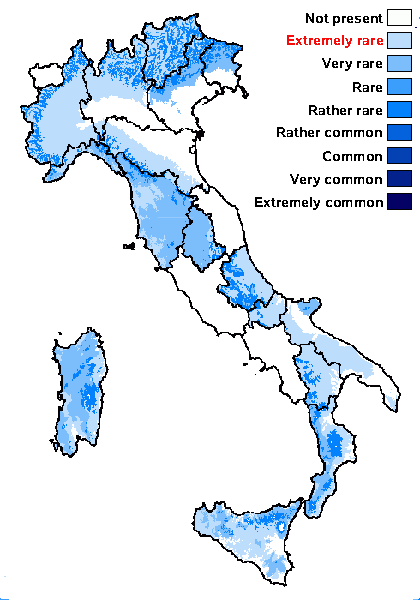
Predictive model
Herbarium samples


P.L. Nimis; Owner: Department of Life Sciences, University of Trieste
Herbarium: TSB (3146)
2001/12/05
upper surface
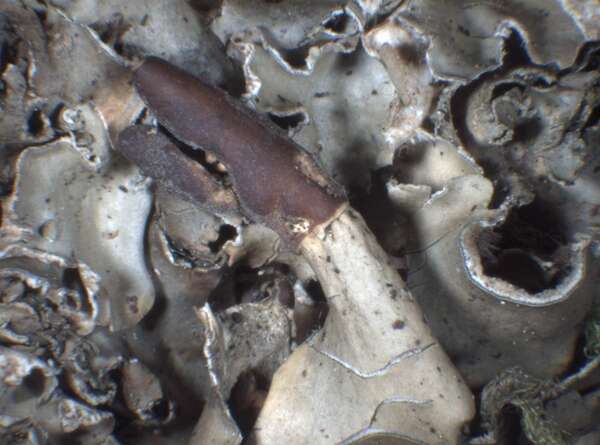

P.L. Nimis; Owner: Department of Life Sciences, University of Trieste
Herbarium: TSB (29246)
2003/03/03
apothecium
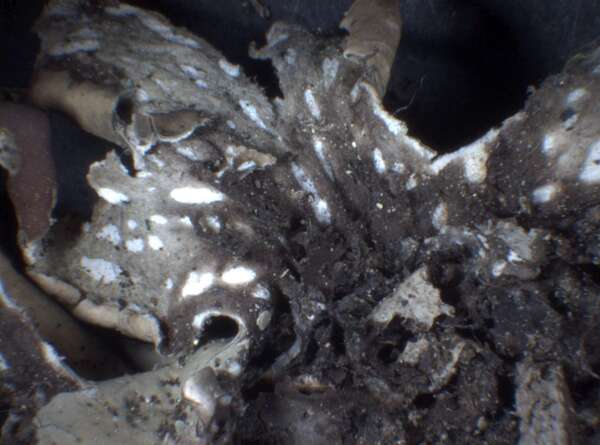

P.L. Nimis; Owner: Department of Life Sciences, University of Trieste
Herbarium: TSB (29246)
2003/03/03
lower surface
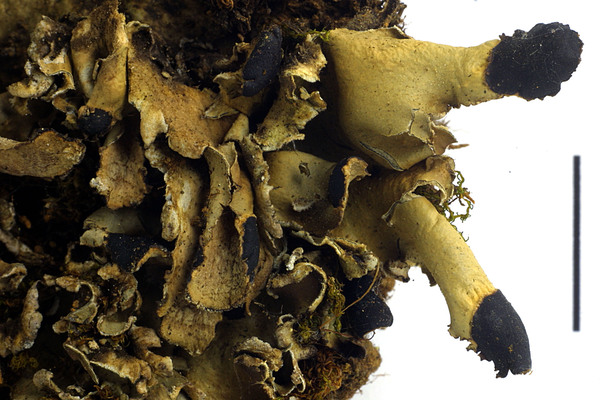

Felix Schumm – CC BY-SA 4.0
[6647], Spanien, Gran Canaria, schattiger, kalter, mit Pinus canariensis bestandener Nordhang an der Straße von Cazadores zum Cruz de Tejeda bei der Caldera de los Marteles; 27°57.658’ N, 15°32.105’ W, 1570 m. Leg. Schumm & Schwarz 28.12.1999, det. Schumm
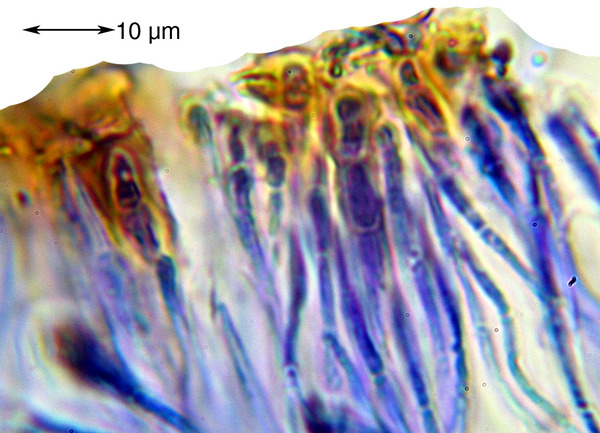

Felix Schumm – CC BY-SA 4.0
[6647], Spanien, Gran Canaria, schattiger, kalter, mit Pinus canariensis bestandener Nordhang an der Straße von Cazadores zum Cruz de Tejeda bei der Caldera de los Marteles; 27°57.658’ N, 15°32.105’ W, 1570 m. Leg. Schumm & Schwarz 28.12.1999, det. Schumm
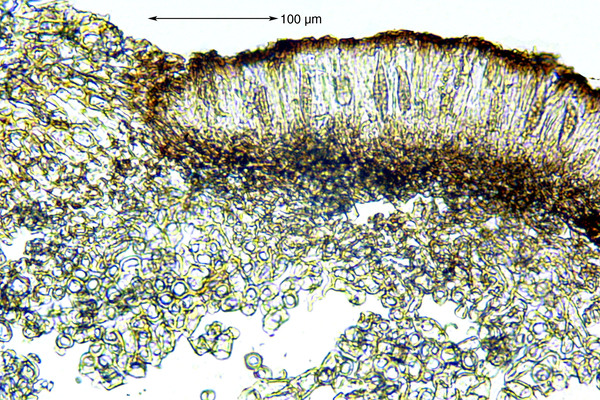

Felix Schumm – CC BY-SA 4.0
[6647], Spanien, Gran Canaria, schattiger, kalter, mit Pinus canariensis bestandener Nordhang an der Straße von Cazadores zum Cruz de Tejeda bei der Caldera de los Marteles; 27°57.658’ N, 15°32.105’ W, 1570 m. Leg. Schumm & Schwarz 28.12.1999, det. Schumm
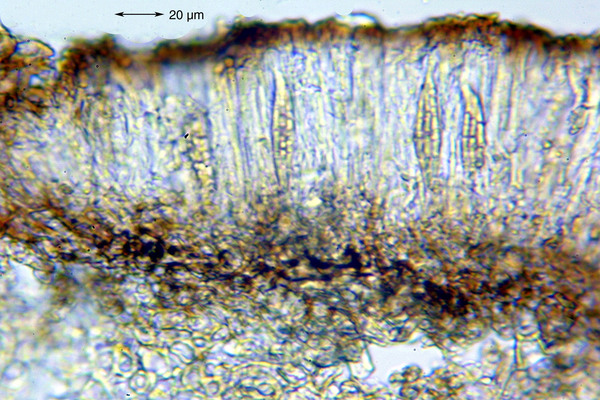

Felix Schumm – CC BY-SA 4.0
[6647], Spanien, Gran Canaria, schattiger, kalter, mit Pinus canariensis bestandener Nordhang an der Straße von Cazadores zum Cruz de Tejeda bei der Caldera de los Marteles; 27°57.658’ N, 15°32.105’ W, 1570 m. Leg. Schumm & Schwarz 28.12.1999, det. Schumm
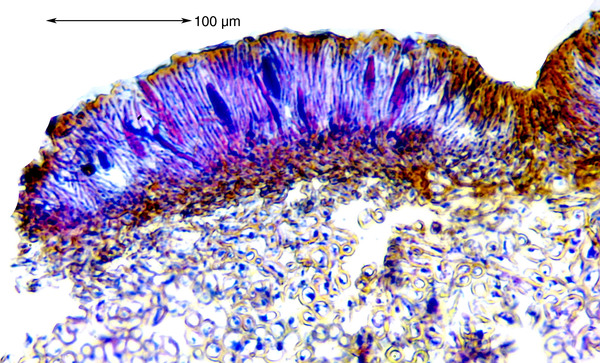

Felix Schumm – CC BY-SA 4.0
[6647], Spanien, Gran Canaria, schattiger, kalter, mit Pinus canariensis bestandener Nordhang an der Straße von Cazadores zum Cruz de Tejeda bei der Caldera de los Marteles; 27°57.658’ N, 15°32.105’ W, 1570 m. Leg. Schumm & Schwarz 28.12.1999, det. Schumm


Felix Schumm – CC BY-SA 4.0
[6647], Spanien, Gran Canaria, schattiger, kalter, mit Pinus canariensis bestandener Nordhang an der Straße von Cazadores zum Cruz de Tejeda bei der Caldera de los Marteles; 27°57.658’ N, 15°32.105’ W, 1570 m. Leg. Schumm & Schwarz 28.12.1999, det. Schumm
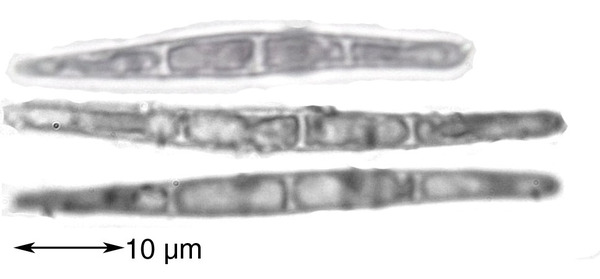

Felix Schumm – CC BY-SA 4.0
[6647], Spanien, Gran Canaria, schattiger, kalter, mit Pinus canariensis bestandener Nordhang an der Straße von Cazadores zum Cruz de Tejeda bei der Caldera de los Marteles; 27°57.658’ N, 15°32.105’ W, 1570 m. Leg. Schumm & Schwarz 28.12.1999, det. Schumm


Felix Schumm – CC BY-SA 4.0
[6647], Spanien, Gran Canaria, schattiger, kalter, mit Pinus canariensis bestandener Nordhang an der Straße von Cazadores zum Cruz de Tejeda bei der Caldera de los Marteles; 27°57.658’ N, 15°32.105’ W, 1570 m. Leg. Schumm & Schwarz 28.12.1999, det. Schumm
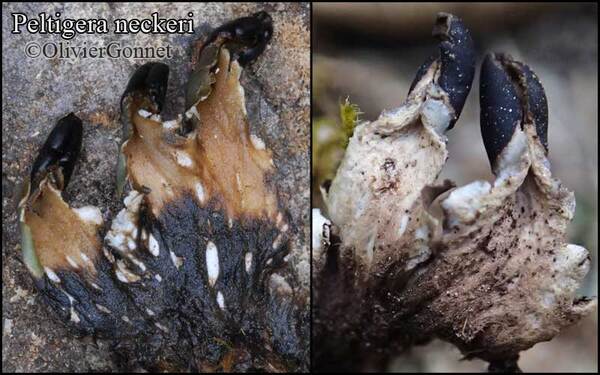
Courtesy Danièle et Olivier Gonnet - Source: https://www.afl-lichenologie.fr/Photos_AFL/Photos_AFL_P/Text_P/Peltigera_neckeri.htm
France, 2015 - Corse
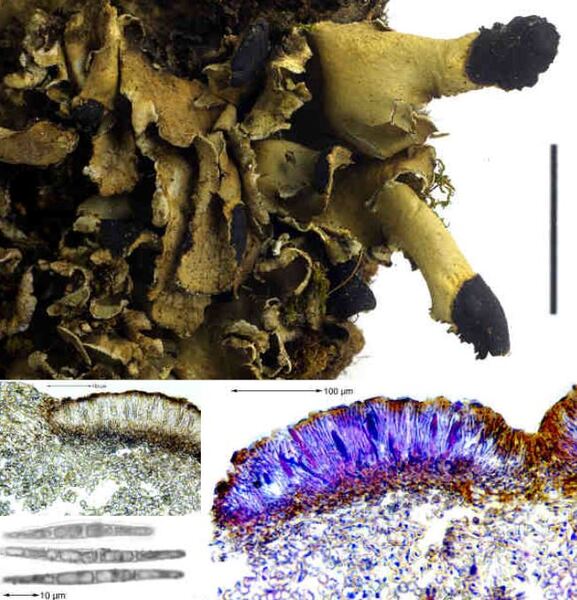

Felix Schumm – CC BY-SA 4.0
Image from: F. Schumm (2008) - Flechten Madeiras, der Kanaren und Azoren. Beck, OHG - ISBN: 978-3-00-023700-3
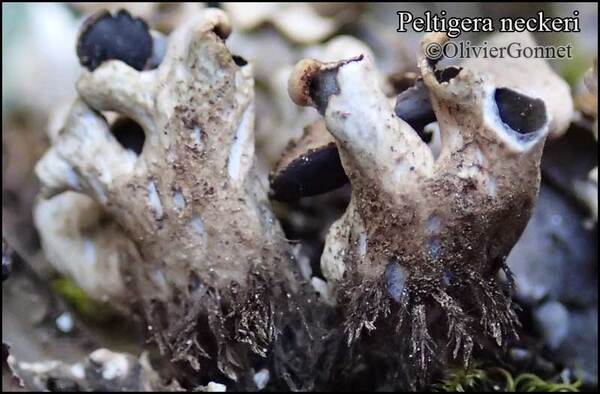
Courtesy Danièle et Olivier Gonnet - Source: https://www.afl-lichenologie.fr/Photos_AFL/Photos_AFL_P/Text_P/Peltigera_neckeri.htm
France, 2015 - Corse
Growth form: Foliose, broad lobed
Substrata: soil, terricolous mosses, and plant debris
Photobiont: cyanobacteria, filamentous (e.g. Nostoc, Scytonema)
Reproductive strategy: mainly sexual
Most common in areas with a humid-warm climate (e.g. most of Tyrrenian Italy)
Commonnes-rarity: (info)
Alpine belt: extremely rare
Subalpine belt: rare
Oromediterranean belt: absent
Montane belt: rather rare
Submediterranean belt: extremely rare
Padanian area: absent
Humid submediterranean belt: very rare
Humid mediterranean belt: extremely rare
Dry mediterranean belt: absent

Predictive model
| Herbarium samples |


P.L. Nimis; Owner: Department of Life Sciences, University of Trieste
Herbarium: TSB (3146)
2001/12/05
upper surface


P.L. Nimis; Owner: Department of Life Sciences, University of Trieste
Herbarium: TSB (29246)
2003/03/03
apothecium


P.L. Nimis; Owner: Department of Life Sciences, University of Trieste
Herbarium: TSB (29246)
2003/03/03
lower surface


Felix Schumm – CC BY-SA 4.0
[6647], Spanien, Gran Canaria, schattiger, kalter, mit Pinus canariensis bestandener Nordhang an der Straße von Cazadores zum Cruz de Tejeda bei der Caldera de los Marteles; 27°57.658’ N, 15°32.105’ W, 1570 m. Leg. Schumm & Schwarz 28.12.1999, det. Schumm


Felix Schumm – CC BY-SA 4.0
[6647], Spanien, Gran Canaria, schattiger, kalter, mit Pinus canariensis bestandener Nordhang an der Straße von Cazadores zum Cruz de Tejeda bei der Caldera de los Marteles; 27°57.658’ N, 15°32.105’ W, 1570 m. Leg. Schumm & Schwarz 28.12.1999, det. Schumm


Felix Schumm – CC BY-SA 4.0
[6647], Spanien, Gran Canaria, schattiger, kalter, mit Pinus canariensis bestandener Nordhang an der Straße von Cazadores zum Cruz de Tejeda bei der Caldera de los Marteles; 27°57.658’ N, 15°32.105’ W, 1570 m. Leg. Schumm & Schwarz 28.12.1999, det. Schumm


Felix Schumm – CC BY-SA 4.0
[6647], Spanien, Gran Canaria, schattiger, kalter, mit Pinus canariensis bestandener Nordhang an der Straße von Cazadores zum Cruz de Tejeda bei der Caldera de los Marteles; 27°57.658’ N, 15°32.105’ W, 1570 m. Leg. Schumm & Schwarz 28.12.1999, det. Schumm


Felix Schumm – CC BY-SA 4.0
[6647], Spanien, Gran Canaria, schattiger, kalter, mit Pinus canariensis bestandener Nordhang an der Straße von Cazadores zum Cruz de Tejeda bei der Caldera de los Marteles; 27°57.658’ N, 15°32.105’ W, 1570 m. Leg. Schumm & Schwarz 28.12.1999, det. Schumm


Felix Schumm – CC BY-SA 4.0
[6647], Spanien, Gran Canaria, schattiger, kalter, mit Pinus canariensis bestandener Nordhang an der Straße von Cazadores zum Cruz de Tejeda bei der Caldera de los Marteles; 27°57.658’ N, 15°32.105’ W, 1570 m. Leg. Schumm & Schwarz 28.12.1999, det. Schumm


Felix Schumm – CC BY-SA 4.0
[6647], Spanien, Gran Canaria, schattiger, kalter, mit Pinus canariensis bestandener Nordhang an der Straße von Cazadores zum Cruz de Tejeda bei der Caldera de los Marteles; 27°57.658’ N, 15°32.105’ W, 1570 m. Leg. Schumm & Schwarz 28.12.1999, det. Schumm


Felix Schumm – CC BY-SA 4.0
[6647], Spanien, Gran Canaria, schattiger, kalter, mit Pinus canariensis bestandener Nordhang an der Straße von Cazadores zum Cruz de Tejeda bei der Caldera de los Marteles; 27°57.658’ N, 15°32.105’ W, 1570 m. Leg. Schumm & Schwarz 28.12.1999, det. Schumm

Courtesy Danièle et Olivier Gonnet - Source: https://www.afl-lichenologie.fr/Photos_AFL/Photos_AFL_P/Text_P/Peltigera_neckeri.htm
France, 2015 - Corse


Felix Schumm – CC BY-SA 4.0
Image from: F. Schumm (2008) - Flechten Madeiras, der Kanaren und Azoren. Beck, OHG - ISBN: 978-3-00-023700-3

 INDEX FUNGORUM
INDEX FUNGORUM
 GBIF
GBIF
 DOLICHENS
DOLICHENS
